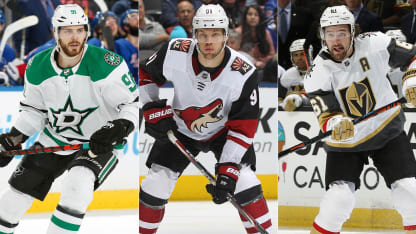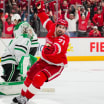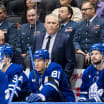With the 2019-20 NHL season on pause due to concerns surrounding the coronavirus, NHL.com will reimagine one NHL Draft each week. Today, we look back at the 2010 NHL Draft, which was held at Staples Center in Los Angeles on June 25-26, 2010.
2010 NHL Redraft: Seguin, Hall flip spots at top
Stone climbs from sixth round to No. 3; Andersen, Gallagher, Klingberg other big risers

There was little fanfare when Mark Stone's name was called at the 2010 NHL Draft. The forward from Brandon of the Western Hockey League was selected by the Ottawa Senators in the sixth round, 177 other players going before him.
Ten years later, he didn't last past the third pick in the NHL.com redraft. The Vegas Golden Knights forward made the biggest leap in the redraft, but he wasn't alone. Goalie Frederik Andersen, who was selected in the seventh round (No. 187) by the Carolina Hurricanes in 2010, also jumped into the top 10, as did John Klingberg, originally selected in the fifth round (No. 131) by the Dallas Stars.
Who else would move up? Who would drop? Would Taylor Hall still go No. 1 over Tyler Seguin? Thirty NHL.com staffers, using the draft order and class from 2010, and selected in random order, have answered those questions. Here are the results. For reference, here is how the original draft went.
1. Tyler Seguin, C, Edmonton Oilers (originally selected No. 2 by Boston Bruins) -- Taylor or Tyler? A decade later, this still was a tough choice. I love Hall as a player, and I know he has been put in more difficult situations than Seguin has. Who knows how their careers might be different had they switched places originally? But in hindsight, I can see the injury problems Hall has had, and the numbers don't lie. Seguin leads the 2010 draft class in games (741), goals (279), assists (356) and points (635). At No. 1, I took the No. 1 producer. -- Nick Cotsonika, columnist
2. Taylor Hall, LW, Boston Bruins (No. 1 by Edmonton Oilers) -- If the Oilers wanted to take Seguin, a fine player and worthy selection, the Bruins were more than happy to use the No. 2 pick to select Hall, who was voted the winner of the Hart Trophy as NHL MVP in 2018. Hall leads the 2010 draft class in points per game (0.90), and his 563 points trail only Seguin despite playing the sixth-most games (627). -- Pat Pickens, staff writer
3. Mark Stone, RW, Florida Panthers (No. 178 by Ottawa Senators) -- Let's check the boxes for Stone: phenomenal hands, hockey IQ off the charts, big heart and tough -- not as a bruiser but that he's tough to deter. Stone has scored at least 20 goals in all six seasons since becoming a full-time NHL player in 2014-15, and with 63 points (21 goals, 42 assists) in 65 games for the Golden Knights when the NHL paused the season, he was one point from matching his NHL career high (2014-15). With those credentials and given that his NHL career appears to still be in its ascent, it was no stretch at all to bring Stone into the top three of this redraft. -- Tim Campbell, staff writer
TBL@VGK: Stone backhands puck by Vasilevskiy for lead
4. Vladimir Tarasenko, RW, Columbus Blue Jackets (No. 16 by St. Louis Blues) -- The best pure goal-scorer in the draft fell in my lap. Yes, three players from the 2010 draft have more NHL goals (Seguin, Hall and Jeff Skinner), but Tarasenko has played 507 games; Seguin has a 65-goal lead on Tarasenko (214 goals) but has played 234 more games. Tarasenko has five consecutive seasons of at least 33 goals on his resume (2014-19) and isn't afraid of the big stage, as evidenced by his performance during the Blues' run to the Stanley Cup last season (17 points; 11 goals, six assists). No disrespect to the players already selected, but Tarasenko was a steal at No. 4. -- Brian Compton, deputy managing editor
5. John Klingberg, D, New York Islanders (No. 131 by Dallas Stars) -- One season after drafting their franchise center (John Tavares), the rebuilding Islanders landed the No. 1 defenseman they've been missing for most of the past 20 years. Klingberg is second among defensemen and 14th among all players from the 2010 draft with 291 points (58 goals, 233 assists) in 425 games, fewer than any of the players ahead of him and 254 fewer than Cam Fowler, the only defenseman who's outscored him (by 10 points). For a team that hasn't had a defenseman score more than 300 points since the dynasty days of the early 1980s, Klingberg is a gift from heaven. -- John Kreiser, managing editor
6. Frederik Andersen, G, Tampa Bay Lightning (No. 187 by Carolina Hurricanes) -- Yes, I know Andersen didn't sign with Carolina and was eventually selected by the Anaheim Ducks in the 2012 NHL Draft (No. 87). But with the Lightning not having a franchise goalie at the time like the Hurricanes did with Cam Ward, I was confident Tampa Bay could keep Andersen. How much of a steal was this pick? Not only are Andersen's 213 NHL wins the most among goalies selected in 2012, they are the most of any goalie in the 2010 class, far ahead of the 122 of Petr Mrazek. Andersen has become a top-flight goalie in the NHL. Just imagine what his numbers would be had he started his North American professional career in 2010. -- Bill Price, Editor-in-Chief
7. Evgeny Kuznetsov, C, Carolina Hurricanes (No. 26 by Washington Capitals) -- The Hurricanes were ecstatic to see Kuznetsov still on the board at this point. The fact that he stayed in Russia for almost four more years after being drafted had an impact on his stats. Consider this: Since 2014-15, his first full season in the NHL, Kuznetsov is first in assists (263), second in points (380; Seguin, 430), second in rating (plus-63; Stone, plus-70) and fourth in power-play points (110) among players drafted in 2010. Surprisingly, Kuznetsov is third among forwards in his draft class in that time frame with 240 penalty minutes (Austin Watson, 358; Ryan Johansen, 326). -- Sebastien Deschambault, managing editor, LNH.com
PIT@WSH: Kuznetsov banks puck in to trim deficit
8. Ryan Johansen, C, Atlanta Thrashers (No. 4 by Columbus Blue Jackets) -- The Thrashers were retooling after trading left wing Ilya Kovalchuk to the New Jersey Devils on Feb. 4, 2010, and having a big (6-foot-3, 218 pounds), skilled center such as Johansen drop to them at No. 8 would've help speed along that process. Johansen ranks third among players from the 2010 draft with 298 assists, behind Seguin and Hall, who has 345, and his 442 points are fourth behind Seguin, Hall and Skinner, who has 465. He also has taken the most face-offs (10,365) and has the highest winning percentage (53.1 percent) in the 2010 class (minimum 10 face-offs). -- Tom Gulitti, staff writer
9. Jaden Schwartz, LW, Minnesota Wild (No. 14 by St. Louis Blues) -- The Wild were thin at forward heading into this draft, so being able to select Schwartz at No. 9 was a steal. He has 364 points (146 goals, 218 assists) in 520 NHL games, and he's been incredibly consistent throughout his career, getting at least 55 points in five of the six seasons he's played at least 62 games. He also plays a solid two-way game, leading the Blues with 342 takeaways since 2013-14 and ranking fifth among players selected in the 2010 draft with a plus-72 rating. Schwartz has had a knack for showing up in big moments; he led the Blues with 12 goals in the 2019 Stanley Cup Playoffs to help them win the Stanley Cup for the first time in their 51-season history, including a natural hat trick in a 3-2 win in Game 6 of the Western Conference First Round that eliminated the Winnipeg Jets. -- Brett Amadon, staff writer
10. Justin Faulk, D, New York Rangers (No. 37 by Carolina Hurricanes) -- The Rangers needed to get deeper at defenseman, so it made sense to take Faulk at No. 10. His 90 goals are the most among defensemen in the 2010 class, and his 274 points (90 goals, 184 assists) in 628 NHL games are third, as is his average of 22:58 of ice time per game. Of Faulk's 90 goals, 41 have come on the power play, 15 more than Fowler, who is second among defensemen drafted in 2010. Going into 2010-11, New York was in great shape at goalie with Henrik Lundqvist and deep at center with Brandon Dubinsky, Derek Stepan and Artem Anisimov. Adding Faulk at defenseman would've bolstered a young group that also included Ryan McDonagh. -- Tracey Myers, staff writer
11. Jeff Skinner, LW, Dallas Stars (No. 7 by Carolina Hurricanes) -- It's tough to turn down scoring, so the Stars went with the player who was voted winner of the Calder Trophy as NHL rookie of the year for 2010-2011, when he had 63 points (31 goals, 32 assists) for the Hurricanes. Skinner has had his ups and downs -- a big up with an NHL career-high 40 goals in 2018-2019 has been followed by a big down with 23 points (14 goals, 9 assists) in 59 games this season -- but it's hard to ignore that he's second in the 2010 draft class with 258 goals and 11th with 207 assists. Dallas was 12th in the NHL in scoring in 2009-10 (2.80 goals per game) and 17th in 2010-11 (2.71), so adding Skinner to the roster makes sense. -- Amalie Benjamin, staff writer
BUF@ARI: Skinner tips Simmonds' backhand set-up home
12. Brendan Gallagher, RW, Anaheim Ducks (No. 147 by Montreal Canadiens) -- There isn't a stats category to measure what beats in a man's chest, so I went with that huge intangible and pulled the lion-hearted Gallagher off the board well before he originally went in 2010. Gallagher (5-9, 184) has forever played taller and heavier than his size. He is fifth in the 2010 class in goals (173) and 10th in games (547) and points (334). Better yet: Since house league, he's been driving opposing goalies and defensemen quite mad, a beast at the crease who leads his teammates in every way, on and off the ice, and in the race for ice packs. -- Dave Stubbs, columnist
13. Tyler Toffoli, RW, Phoenix Coyotes (No. 47 by Los Angeles Kings) -- The Coyotes had four players with at least 41 points and one with more than 19 goals in 2009-10, each a total Toffoli has reached in four of his past six NHL seasons. In addition to his 300 points (145 goals, 155 assists) ranking 12th among players drafted in 2010, his plus-82 rating (tied with Seguin for first) shows he's responsible defensively. Toffoli has 21 points (nine goals, 12 assists) in 47 NHL playoff games, including seven goals and seven assists in 26 games to help the Kings win the Cup in 2014, and is the kind of player the Coyotes needed. -- David Satriano, staff writer
14. Cam Fowler, D, St. Louis Blues (No. 12 by Anaheim Ducks) -- The Blues acquired the No. 16 pick in a draft-day trade with the Senators, so it was an easy decision to take Fowler here to shore up the St. Louis defenseman group. Fowler leads defensemen chosen in the 2010 draft in assists (234), points (301) and blocked shots (960), and he is second in goals (67). His 679 games rank third in the 2010 draft class behind Seguin (741) and Skinner (720), and he is fourth in power-play points with 120. One interesting note: Forward Artemi Panarin was eligible for the NHL Draft for the first time in 2010 but wasn't selected. -- Mike G. Morreale, staff writer
15. Brock Nelson, C, Los Angeles Kings (No. 30 by New York Islanders) -- This was the point in the redraft where some skaters were standalone producers and others benefited from having elite linemates. Nelson, an ideal fit as the Kings' No. 2 center behind Anze Kopitar, has proven he can consistently score goals regardless of who's playing on his line. Nelson, who has scored at least 19 goals in six of his seven NHL seasons, quietly ranks sixth in the 2010 class in goals (150). He had an NHL career-high 54 points (26 goals, 28 assists) in 68 games before the season was paused, including his highest goals-per-game (0.38) and points-per-game averages (0.79). -- Pete Jensen, senior fantasy editor
16. Kevin Hayes, C, St. Louis Blues (No. 24 by Chicago Blackhawks) -- Strength up the middle remains a successful blueprint for success, and that's what the Blues got with the second of two selections in the span of three picks. After Morreale landed St. Louis a smooth-skating, puck-moving defenseman at No. 14, the Blues added skill and muscle at center with Hayes. His size (6-5, 216) alone makes him a disruptive force on the forecheck, but his versatility also played into the decision. He's scored at least 14 goals in each of his six NHL seasons and has been effective on the power play with 44 points (18 goals, 26 assists), many of those accrued in the dirty areas in front of the net. Defensively, he's chipped in with 10 shorthanded goals, including four this season, his first with the Philadelphia Flyers, and has thrived in the role of shutdown center assigned to smother the opposition's top line. -- Mike Zeisberger, staff writer
17. Mikael Granlund, C, Colorado Avalanche (No. 9 by Minnesota Wild) -- Three forwards in the 2010 class have averaged more ice time per game than Granlund's 17:57 (Hall, 19:05; Stone, 18:55; and Seguin, 18:28), and each has already been selected, so one of the most underrated centers in the NHL was the pick here. Granlund can do it all with the ability to play in all three zones. He is plus-51 in shot attempts differential at 5-on-5 in his NHL career, tied for 20th among players drafted in 2010 (minimum 250 games), and his eight shorthanded goals are second. He had at least 41 points in five of his first six full NHL seasons, and his 352 points are fourth among centers from the 2010 draft. That's more than acceptable production from a player taken in the second half of the first round. -- Shawn P. Roarke, Senior Director of Editorial
CGY@NSH: Granlund ties game late, pots OT winner
18. Nino Niederreiter, RW, Nashville Predators (No. 5 by New York Islanders) -- The Islanders were coming off their third straight season missing the playoffs and jumped at the chance to take Niederreiter, who had 36 goals and 60 points in his first season with Portland of the WHL. Though Niederreiter became the youngest player in Islanders history at 18 years, 31 days when he made his NHL debut Oct. 9, 2010, and the youngest to score a goal four days later, he needed time to develop (two goals in 64 games from 2010-12). The Predators, coming off a 100-point season, had the time. Niederreiter ranks 12th in the 2010 draft class with 137 goals and 15th in points with 290. He scored at least 20 goals in four of the past five seasons, including an NHL career-high 25 for the Wild in 2016-17. -- Frank Giase, staff writer
19. Charlie Coyle, C, Florida Panthers (No. 28 by San Jose Sharks) -- Coyle is the big (6-3, 220), two-way center any team would love to build around. All you have to do is watch how Coyle helped the Bruins reach the 2019 Stanley Cup Final, his nine postseason goals tied with Patrice Bergeron, Brad Marchand and David Pastrnak for the Boston lead. Among players drafted in 2010, Coyle is 13th with 1.01 assists per 60 minutes at 5-on-5 (minimum 100 games) despite being 24th in 5-on-5 ice time per game (13:24). He's also plus-48 in even-strength goal differential, tied for eighth among forwards in the 2010 class. -- Adam Kimelman, deputy managing editor
20. Bryan Rust, RW, Pittsburgh Penguins (No. 80 by Pittsburgh Penguins) -- This was an extremely difficult decision between two current Penguins, Bryan Rust and Jason Zucker, but going with the player who has been with the organization since Day One just felt right. Of course, Pittsburgh would have to take him 60 picks earlier than it did 10 years earlier, but it would be well worth it. Rust didn't make an impact for the Penguins until 2016-17, but since that season, he has 157 points in 253 games, an average of 0.62 points per game, which is tied for 13th among players in the 2010 class in that span. He has had a breakout season in 2019-20, with 56 points (27 goals, 29 assists) in 55 games. Rust's hard-nosed style of play fits in well with the core of stars already in place, and the Penguins would be thrilled to lock him up in this spot. -- Matt Cubeta, Editor-in-Chief, NHL.com International
21. Jason Zucker, LW, Detroit Red Wings (No. 59 by Minnesota Wild) -- The Red Wings went with Zucker to help replenish an aging roster. He had NHL career highs in goals (33), assists (31) and points (64) for the Wild in 2017-18, and scored 132 goals for them from 2012-13 until he was traded to the Penguins on Feb. 10, second on Minnesota in that span behind Zach Parise's 192. Energized by the trade, Zucker has scored six goals in 15 games playing left wing on Sidney Crosby's line. -- Jon Lane, staff writer
22. Zach Hyman, C, Montreal Canadiens (No. 123 by Florida Panthers) -- Hyman's 71 goals may be 22nd in the 2010 draft class, but he has played the fewest games of any of the top 30 scorers, not becoming a full-time NHL player until 2016-17. Never afraid to mix it up in corners to dig out the puck, Hyman has 152 points (71 goals, 81 assists) in 302 NHL games (Rust is next with 308 games), including a 21-goal season in 2018-19 and 21 goals in 51 games at the pause this season, showing he is really starting to blossom. -- Dan O'Leary, staff writer
23. Philipp Grubauer, G, Buffalo Sabres (No. 112 by Washington Capitals) -- Yes, the Sabres still had an elite goalie, Ryan Miller, but it never hurts to add a strong backup who can be groomed as the future No. 1. Often a backup throughout his NHL career, Grubauer has proven that he can handle the starting gig when called upon: His 2.44 goals-against average and .920 save percentage in 174 games (148 starts) are tops among goalies drafted in 2010, and in the 2019 playoffs with the Avalanche, he had a 2.30 GAA and .925 save percentage in 12 games. -- John Ciolfi, senior producer, LNH.com
Grubauer wears GoPro at Stadium Series practice
24. Brett Connolly, RW, Chicago Blackhawks (No. 6 by Tampa Bay Lightning) -- Having just won their first Stanley Cup since 1961, the Blackhawks already had a talented roster that included several elite players. Connolly's selection would have added the necessary depth to help them continue winning, like he provided the Capitals during their run to the Cup in 2018. With 188 points (98 goals, 90 assists) in 496 games for the Lightning, Bruins, Capitals and Panthers, the big forward (6-3, 192) has scored at least 15 goals in four straight seasons. At the pause, he was one goal shy of reaching 20 for the second straight season, after he had an NHL career-high 22 for Washington in 2018-19. -- Guillaume Lepage, staff writer, LNH.com
25. Radko Gudas, D, Florida Panthers (No. 66 by Tampa Bay Lightning) -- After taking Stone at No. 3 and Coyle at No. 19, the Panthers used their third first-round selection for help at defenseman. With Gudas, they also infused a healthy dose of physicality; he has 1,648 hits in eight NHL seasons, 429 more than anyone else drafted in 2010, so it follows that his average of 11.33 hits per 60 minutes is the highest among those who have played at least 320 games. In 479 NHL games, Gudas has 841 blocked shots, second in the 2010 class, and is plus-26, second among 2010 defensemen (Klingberg, plus-35). -- Barry Rubinstein, manager, assignments
26. Nick Bjugstad, C, Washington Capitals (No. 19 by Florida Panthers) -- He's 17th among forwards from the 2010 draft with 207 points (97 goals, 110 assists) in 439 games. Bjugstad's 46 power-play points are 16th and his 1,073 shots on goal are 13th. Bjugstad would have been a solid value pick here for the Capitals, who originally selected Kuznetsov with this pick. Bjugstad would have capably filled the role of No. 2 center behind Nicklas Backstrom, and his 681 hits (11th in 2010 class) would have complemented their physical style of play. -- Rob Reese, fantasy editor
27. Petr Mrazek, G, Phoenix Coyotes (No. 141 by Detroit Red Wings) -- Mrazek would have been a good fit for the Coyotes, who had Mike Smith as their No. 1 goalie beginning in 2011-12, giving Mrazek time to develop. He is first among goalies selected in 2010 in games (263), wins (122) and shutouts (21), and he is third with a 2.62 GAA, behind Grubauer and Jack Campbell (2.58). He has played at least 40 games four times and won at least 21 games three times over the past six seasons with the Red Wings, Flyers and Hurricanes. -- Jim Cerny, senior editor
28. Jesper Fast, RW, San Jose Sharks (No. 157 by New York Rangers) -- The Sharks went with Fast here, valuing the more defensive-minded forward who can play in a top-six role, as he has this season with the Rangers, or in a bottom-six role, as he has done in the past. Fast is an aggressive and relentless forechecker and penalty killer. He does a lot of the grinding, dirty work on his line but manages to produce some offense. He has 29 points (12 goals, 17 assists) in 69 games this season. He is one off his NHL career highs in goals and points. But the majority of his presence is felt on the defensive end, especially on the PK. -- Dan Rosen, senior writer
29. Joonas Donskoi, RW, Anaheim Ducks (No. 99 by Florida Panthers) -- It took Donskoi five years to crack the NHL, which he did at age 23 after winning the Jari Kurri Trophy with Karpat in Liiga his native Finland as playoff MVP in 2015. As a rookie, he helped the Sharks to the 2016 Stanley Cup Final, when they lost to the Penguins in six games, with 12 points (six goals, six assists) in 24 playoff games. A reliable and consistent third-line forward, Donskoi has scored at least 11 goals and 32 points in four of his five NHL seasons, including a career-highs 16 goals in 65 games for the Avalanche this season. He is 23rd in goals (61) and 21st in assists (94) among forwards from the 2010 draft. -- Paul Strizhevsky, columnist, NHL.com/ru
30. Video: TBL@VGK: Stone backhands puck by Vasilevskiy for lead, RW, New York Islanders (No. 42 by Anaheim Ducks) -- Smith-Pelly is another player who's had his ups and downs, but his ups have been really high, making it impossible for me to pass him up with the final pick of this redraft. Although he has averaged 0.26 points per game in the NHL (101 points in 395 games; 44 goals, 57 assists), he's stepped up in the playoffs, with 13 goals in 51 playoff games (0.25 per game), including the tying goal for the Capitals in their Cup-winning Game 5 victory against the Golden Knights in 2018. He scored seven goals in 24 postseason games during Washington's championship run. Without an NHL contract this season, he played for Kunlun in the Kontinental Hockey League. In the NHL, Smith-Pelly has been a third- or fourth-line forward who provides a physical presence, as evidenced by his 801 hits (seventh in 2010 class). -- William Douglas, staff writer

















